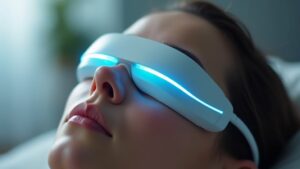Cranial Electrotherapy Stimulation (CES) uses mild electrical currents to influence brain activity, offering a potential lifeline for those struggling with anxiety, depression, or chronic pain. By targeting neural pathways, CES might help rebalance brain chemistry without medication, making it an appealing option for people seeking alternatives to traditional treatments. While research continues to examine its full potential, initial findings suggest CES could ease symptoms for some, igniting curiosity about its broader applications. The therapy’s non-invasive nature and minimal side effects add to its growing appeal.
How Cranial Electrotherapy Stimulation Works
How exactly does cranial electrotherapy stimulation influence the brain? CES delivers gentle electrical stimulation to the brain, which can help restore neurochemical balance through affecting key areas like the hypothalamus. This region regulates neurochemicals linked to mood, emotion, sleep, and cognition.
When stress disrupts normal brain activity, CES might correct imbalances by modulating electrical signals. Some theories suggest it stimulates the vagus nerve, sending calming parasympathetic signals to the brain. While the exact mechanisms remain unclear, studies indicate CES could influence brainwave patterns, like alpha activity, and regions such as the default mode network.
Medical Conditions Treated With CES
Because it sends small electrical impulses to the brain, cranial electrotherapy stimulation has been investigated as a treatment for several mental health and sleep-related conditions. Research suggests CES could help manage specific conditions, though evidence quality varies.
- Anxiety: Five randomized controlled trials support CES for reducing anxiety symptoms, with some showing consistent improvement compared to placebos.
- Depression: While some small studies report benefits, rigorous placebo-controlled trials are lacking, leaving its effectiveness uncertain.
- Chronic Pain: Preliminary findings suggest electrical stimulation might ease discomfort, but more research is required to verify results.
- Insomnia: Placebo-controlled trials show mixed outcomes, with some reporting better sleep but others finding no significant difference.
Though CES shows promise for mental health and pain management, stronger studies are essential to confirm its function as a reliable treatment.
How CES Compares to Other Therapies
Exploring treatment options often feels overwhelming, especially as decisions are constructed weighing choices like cranial electrotherapy stimulation against traditional therapies. CES offers a non-pharmaceutical approach using gentle electrical stimulation, contrasting with medications that could have stronger side effects.
For anxiety, research shows CES can be as effective as psychotherapy, though it’s less proven for depression—findings vary study through study. While useful for insomnia, results aren’t always consistent. Compared to cognitive-behavioral therapy, CES might not match its long-term benefits for mental health.
However, for those seeking a drug-free option, auricular electrostimulation provides a convenient alternative. Pain management with CES also avoids medication dependence, rendering it appealing whenever traditional treatments aren’t ideal. The choice depends on individual needs and preferences.
Side Effects and Safety of CES
- Mild Reactions: Some users report temporary headaches or tingling, which usually fade quickly.
- Rare Risks: No evidence suggests long-term harm, but high-risk individuals should consult a doctor.
- Proper Use: Following guidelines minimizes discomfort, like guaranteeing correct electrode placement.
- Safety Measures: Avoid operating machinery during sessions to prevent accidents.
Understanding these factors secures safer use of CES.
What to Expect During CES Treatment
A CES treatment session is straightforward and non-invasive, typically lasting 20 to 60 minutes per session. During cranial electrostimulation therapy, small electrodes are placed on the earlobes, delivering gentle electrical stimulation to the brain.
The CES device is easy to use, and patients often relax or engage in quiet activities during treatment. For conditions like depression or opioid withdrawal, daily sessions for three to six weeks are common, followed by maintenance treatments two to three times weekly. Side effects are rare but monitored throughout initial sessions.
The cost of a CES device ranges from $600 to $800, depending on features. Treatment duration and frequency vary based on individual needs, with many users reporting gradual improvements in symptoms over time.
Conclusion
Cranial Electrotherapy Stimulation offers a promising, drug-free approach to managing anxiety, depression, and chronic pain. Research suggests it can help up to 70% of users with mild to moderate anxiety find relief. While not a cure-all, CES provides a safe alternative with minimal side effects when used correctly. As more studies investigate its benefits, this therapy could become a key tool in mental health and pain management, offering hope for those seeking non-medication options.




